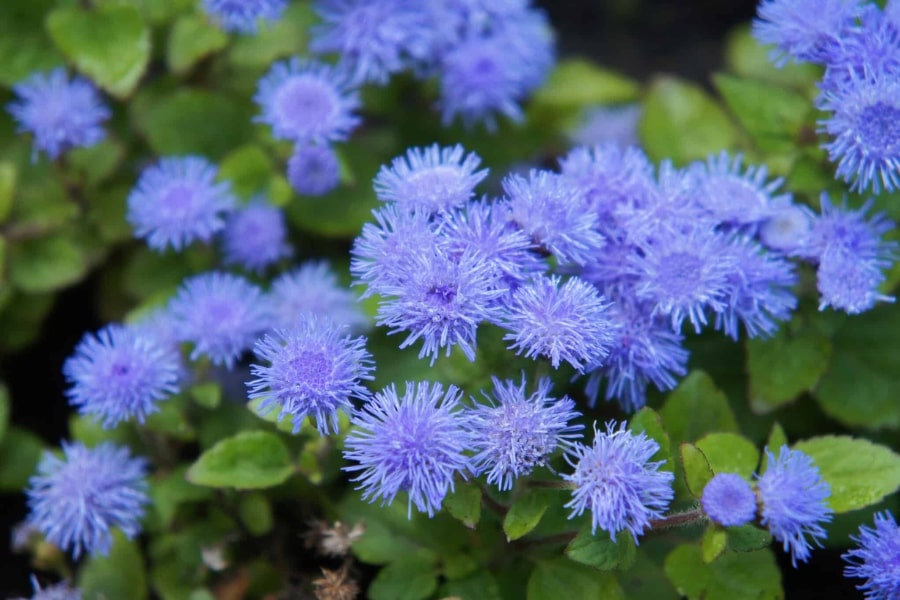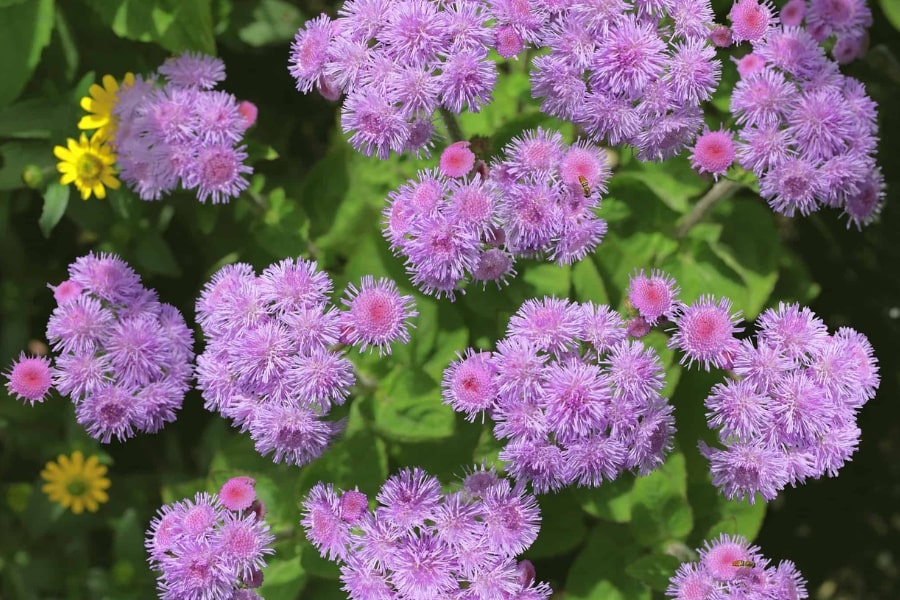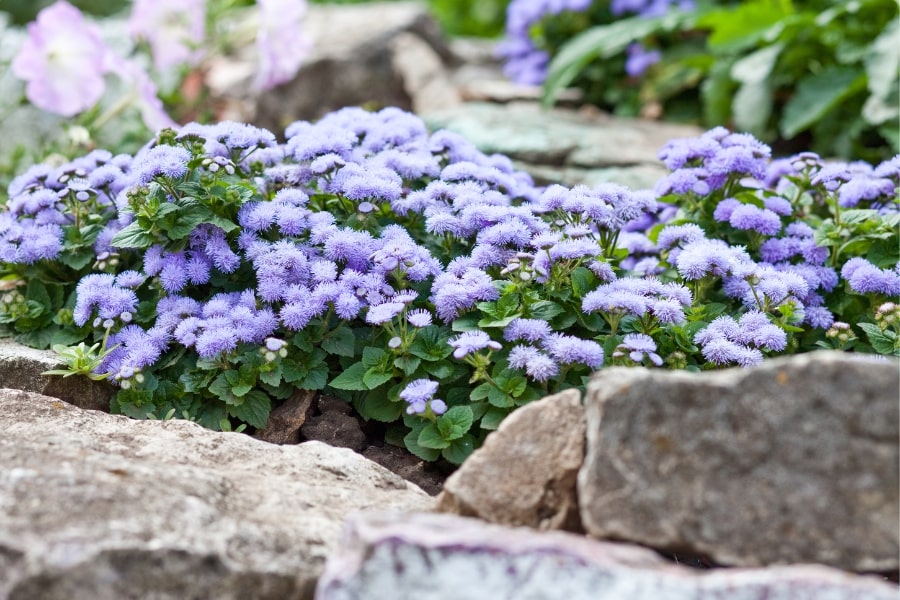Commonly known as Floss Flower, Ageratum is a charming Annual flowering plant cherished for its fluffy clusters of blue, pink, or white blossoms. Belonging to the Asteraceae family, Ageratum species are native to Central America, although they have become popular ornamental plants in gardens worldwide. Ageratum plants typically reach heights ranging from 6 to 24 inches (15 to 60 cm) and spread to about 6 to 18 inches (15 to 45 cm) wide, forming compact mounds of foliage adorned with clusters of fluffy flowers.

Our Selection of Ageratum
At Martin Garden Center, we think Ageratum is underrated. While we don’t currently grow it ourselves, we proudly carry multiple varieties provided by our trusted vendors in 4″ containers. This includes the Artist series, Blue Danube and Hawaii White. Beginning April 1, we carry flats of Aloha Blue and any leftover is potted up into 4″ containers in July.
- The Artist® Series is known for its compact habit and rich lavender-blue blooms that hold up well in humid Southern climates.
- Blue Danube offers classic soft-blue flowers and slightly taller growth, ideal for mid-border plantings.
- Hawaii White provides a clean white accent that brightens mixed containers.
- Aloha Blue performs beautifully in hot weather with abundant blooms and strong branching.
Growing and Caring For Ageratum
Ageratum thrives in conditions that mimic its native habitat. It prefers full sun, although it can tolerate partial shade in hotter climates. Providing at least 6 hours of sunlight daily promotes healthy growth and abundant flowering. Ageratum prefers well-draining soil with a slightly acidic to neutral pH. Amend heavy or clay soils with organic matter, such as compost or peat moss, to improve drainage and fertility. Container-grown Ageratum benefits from a lightweight potting mix formulated for annual flowers. Ageratum thrives in warm temperatures and is sensitive to frost. Plant it outdoors after the danger of frost has passed in Spring, and enjoy its blooms throughout the Summer and Fall months.
Keep the soil consistently moist but not waterlogged. Water Ageratum regularly, especially during hot, dry weather, to prevent the soil from drying completely. Mulching around the plants helps retain soil moisture and suppress weed growth. Feed Ageratum with a balanced liquid fertilizer every 4 to 6 weeks during the growing season to promote healthy growth and prolific flowering. Avoid excessive nitrogen, as it can lead to lush foliage at the expense of flowers.
Ageratum is one of the plants whose flowers bury the dead, meaning that the plant flowers so profusely that the new bloom covers the fading bloom and consequently you do not need to deadhead. Unfortunately, only the older varieties do this. The newer varieties have long lasting blooms that must be removed else the plant looks aesthetically displeasing.
Ageratum can develop root rot if planted in poorly drained soil or overwatered, so ensure the soil dries slightly between waterings. In humid climates, good air circulation prevents powdery mildew. If flower production slows mid-summer, lightly trim plants by one-third and apply a balanced fertilizer — they’ll quickly rebound with fresh blooms.
Leaves and Flowers
Ageratum leaves are typically ovate to lance-shaped, with serrated edges and a slightly hairy texture. The leaves are arranged oppositely along the stems and range in color from medium green to dark green, depending on the cultivar.
Its flowers are the highlight of the plant, forming dense clusters of small, button-like blossoms atop sturdy stems. The flower heads consist of numerous tubular florets surrounded by a ring of petal-like bracts, giving them a fluffy appearance. Ageratum flowers come in various shades of blue, pink, purple, and white, with blue being the most common color.

Uses in the Garden
- Bedding Plants: Ageratum is commonly used as bedding plants in garden beds, borders, and mass plantings. Their compact growth habit and prolific flowering make them ideal for creating colorful displays in flower gardens and landscape beds.
- Container Gardens: Ageratum adds color and texture to container gardens, window boxes, and hanging baskets. Plant them alongside other annuals and trailing foliage plants to create eye-catching combinations for patios, balconies, and outdoor living spaces.
- Cut Flowers: Ageratum flowers make charming additions to fresh-cut flower arrangements and bouquets. Harvest the blooms when fully open but still in the bud to extend their vase life. Combine them with other garden flowers for delightful floral displays indoors.
- Butterfly Gardens: Ageratum’s nectar-rich flowers attract butterflies, bees, and other pollinators, making them valuable additions to butterfly gardens and pollinator-friendly landscapes. Plant them alongside other flowering plants to create a haven for beneficial insects.

Frequently Asked Questions
Is Ageratum Annual Or Perennial?
Ageratum is typically grown as an annual plant in most regions, as it is sensitive to frost and does not tolerate cold temperatures. It may behave as a short-lived perennial in frost-free climates, blooming for multiple seasons.
Can I Start Ageratum From Seeds?
Yes, Ageratum can be started from seeds indoors or sown directly in the garden after the danger of frost has passed. Start seeds indoors 6 to 8 weeks before the last frost date, and transplant seedlings outdoors once they are well-established and temperatures have warmed.
Are There Any Diseases Or Pests That Affect Ageratum?
Ageratum is relatively resistant to pests and diseases but occasionally encounters issues such as aphids, spider mites, or powdery mildew. Monitor the plants regularly for signs of infestation or disease, and treat them promptly with organic or chemical remedies as needed.
